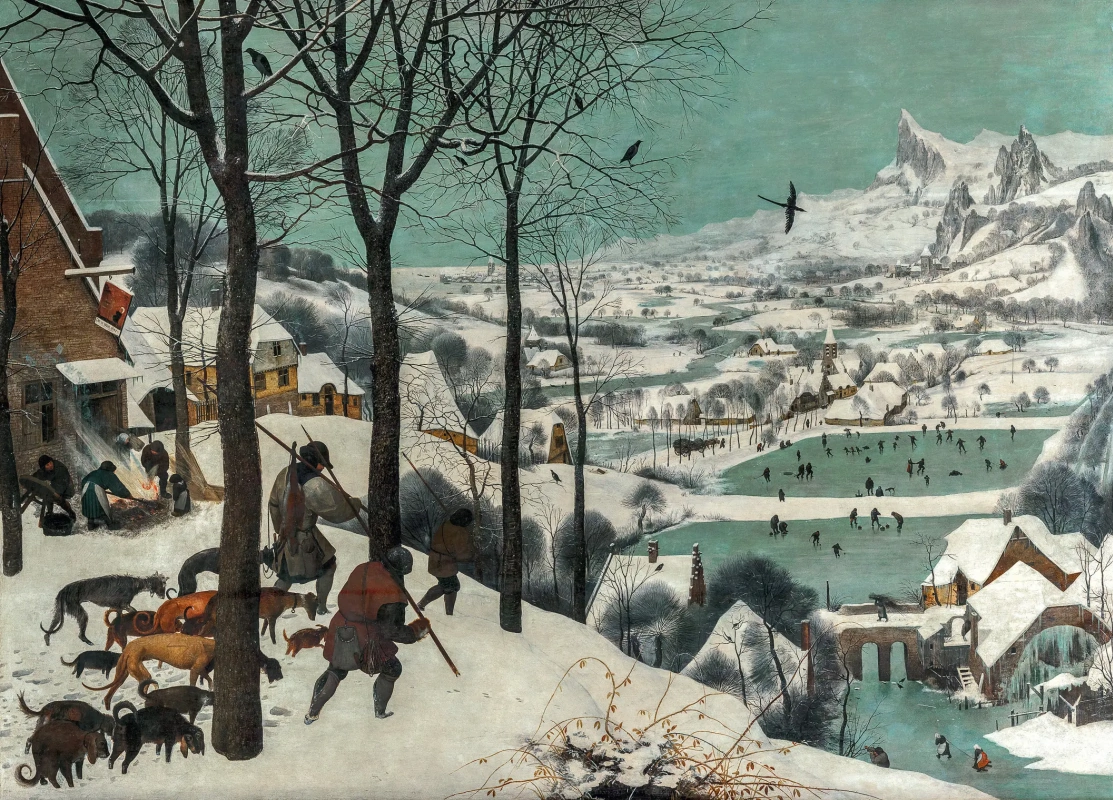увійти
Увійдіть на сайт
Залогіньтесь, щоб використовувати максимум функцій Артхіва
Охотники на снегу. Цикл "Времена года", январь
Питер Брейгель Старший • Живопис, 1565, 117×162 см


















Опис картини «Охотники на снегу. Цикл "Времена года", январь»
«Охотников на снегу» многие считают лучшей картиной Питера Брейгеля Старшего. Она входит в цикл на тему времён года, заказанный художнику антверпенским финансистом Николасом Йонгелинком для украшения его нового дома.
Известно, что весь 1565 год Брейгель посвятил работе над данной серией. Но интереснее другое: судьбу этих картин часто приводят в пример, чтобы объяснить искусство как капиталовложение. Йонгелинк был весьма богат и рано понял, что в картины можно инвестировать. Он приобрёл у Брейгеля «Вавилонскую башню», потом «Несение креста» и, наконец, сообразил, что картины можно не только купить уже готовыми, но и заказать «с нуля». Так он и сделал. Почти сразу после заключения договора с Брейгелем у Йонгелинка возникли финансовые трудности. Чтобы получить крупный денежный займ из городской казны, финансист в качестве его материального обеспечения предоставил документ, подверждавший права на еще не созданные картины Брейгеля, которые, как только были написаны, перекочевали в хранилище казначейства. Там они оказались заперты на несколько десятилетий. Сам художник до своей смерти в 1569 году больше своих работ не увидел.
Из всей серии, которую одни называют «Месяцы», а другие «Времена года» (точное количество входящих в нее картин неизвестно), сохранилось пять работ. Три (1, 2), включая «Охотников на снегу», представлены в Вене, «Жатва» – в Нью-Йорке, «Сенокос» – в Праге.
«Охотники на снегу» – это картина практически без теней. Искусствовед Ольга Сугробова отмечает, что она написана так «будто мы стояли некоторое время с закрытыми глазами и вдруг внезапно открыли их – и оказались на ярком свету». Перед нами великолепный, далеко простирающийся заснеженный вид: покрытые свежим снегом горы и холмы, скованные льдом водоёмы и нидерландцы за своими сезонными занятиями – охотой, катанием на коньках, приготовлением пищи. Здание слева – трактир. На его вывеске написано «У пастуха». Люди подкидывают солому в костёр, на котором готовятся коптить кабана.
Нижняя левая четверть деревянной панели, на которой написана картина, отдана охотникам. Редко в творчестве Брейгеля фигуры людей и собак бывали написаны столь крупными. Сгорбленные спины охотников, отяжелённые ягдташами с добычей, передают их ощущения: они замёрзли и устали. Но Брейгель умышленно скрывает их лица. Он пишет охотников обобщённо. Они выделяются как резкие тёмные пятна на фоне освещенного бело-зелено-голубого пейзажа. И в этом есть позиция Брейгеля: изображать во всём богатстве колорита не человека (что было бы традиционно), а природу. Человек в художественной системе Брейгеля – это лишь часть чего-то неизмеримо большего, часть сотворенного Богом ландшафта, часть мироздания.
Художники до Брейгеля в большинстве своём толковали природу как вечно длящееся лето. Брейгель же открывает величественную красоту зимнего пейзажа.
Интересно, что по мере удаления фигуры и предметы на картине Брейгеля уменьшаются в размерах, но не теряют чёткости контуров, поэтому «Охотники на снегу» допускают значительное приближение без потери качества. Даже в самой маленьком из своих фрагментов картина остаётся шедевром.
Автор: Анна Вчерашняя
Известно, что весь 1565 год Брейгель посвятил работе над данной серией. Но интереснее другое: судьбу этих картин часто приводят в пример, чтобы объяснить искусство как капиталовложение. Йонгелинк был весьма богат и рано понял, что в картины можно инвестировать. Он приобрёл у Брейгеля «Вавилонскую башню», потом «Несение креста» и, наконец, сообразил, что картины можно не только купить уже готовыми, но и заказать «с нуля». Так он и сделал. Почти сразу после заключения договора с Брейгелем у Йонгелинка возникли финансовые трудности. Чтобы получить крупный денежный займ из городской казны, финансист в качестве его материального обеспечения предоставил документ, подверждавший права на еще не созданные картины Брейгеля, которые, как только были написаны, перекочевали в хранилище казначейства. Там они оказались заперты на несколько десятилетий. Сам художник до своей смерти в 1569 году больше своих работ не увидел.
Из всей серии, которую одни называют «Месяцы», а другие «Времена года» (точное количество входящих в нее картин неизвестно), сохранилось пять работ. Три (1, 2), включая «Охотников на снегу», представлены в Вене, «Жатва» – в Нью-Йорке, «Сенокос» – в Праге.
«Охотники на снегу» – это картина практически без теней. Искусствовед Ольга Сугробова отмечает, что она написана так «будто мы стояли некоторое время с закрытыми глазами и вдруг внезапно открыли их – и оказались на ярком свету». Перед нами великолепный, далеко простирающийся заснеженный вид: покрытые свежим снегом горы и холмы, скованные льдом водоёмы и нидерландцы за своими сезонными занятиями – охотой, катанием на коньках, приготовлением пищи. Здание слева – трактир. На его вывеске написано «У пастуха». Люди подкидывают солому в костёр, на котором готовятся коптить кабана.
Нижняя левая четверть деревянной панели, на которой написана картина, отдана охотникам. Редко в творчестве Брейгеля фигуры людей и собак бывали написаны столь крупными. Сгорбленные спины охотников, отяжелённые ягдташами с добычей, передают их ощущения: они замёрзли и устали. Но Брейгель умышленно скрывает их лица. Он пишет охотников обобщённо. Они выделяются как резкие тёмные пятна на фоне освещенного бело-зелено-голубого пейзажа. И в этом есть позиция Брейгеля: изображать во всём богатстве колорита не человека (что было бы традиционно), а природу. Человек в художественной системе Брейгеля – это лишь часть чего-то неизмеримо большего, часть сотворенного Богом ландшафта, часть мироздания.
Художники до Брейгеля в большинстве своём толковали природу как вечно длящееся лето. Брейгель же открывает величественную красоту зимнего пейзажа.
Интересно, что по мере удаления фигуры и предметы на картине Брейгеля уменьшаются в размерах, но не теряют чёткости контуров, поэтому «Охотники на снегу» допускают значительное приближение без потери качества. Даже в самой маленьком из своих фрагментов картина остаётся шедевром.
Автор: Анна Вчерашняя




